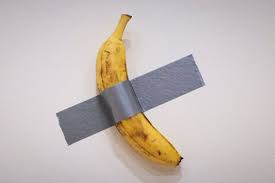In a world where art often mirrors society’s complexities and contradictions, Italian artist Maurizio Cattelan has once again captured the public’s imagination with his provocative creation — a simple banana taped to a wall. What makes this piece remarkable is not the fruit or the tape, but the staggering $6.2 million it commanded at a New York auction on Wednesday. Sotheby’s announcement of the sale has reignited debates about the nature of art, value, and the boundary between absurdity and genius.
Maurizio Cattelan, known for his boundary-pushing works, first presented the banana as part of his series of conceptual art pieces designed to challenge conventional definitions of artistic value. Titled Comedian, the artwork made waves when it debuted at Art Basel in Miami Beach in 2019. The piece quickly became a cultural phenomenon, attracting crowds and sparking fierce debates. To some, it was an insightful critique of consumerism and the commodification of art; to others, it was nothing more than a prank disguised as high art.
The sale of the banana for $6.2 million to a cryptocurrency entrepreneur has elevated its notoriety to new heights. This transaction, conducted within the high-profile auction space of Sotheby’s, signals a shift in how art intersects with emerging financial systems and digital currencies. It is emblematic of how wealth in the 21st century, particularly in cryptocurrency, is reshaping traditional markets, including the art world. The buyer’s identity — a figure from the cryptocurrency world — adds an extra layer of intrigue, suggesting that this purchase might also be a statement about the fluidity of value in both art and finance.
The banana itself is ephemeral; it will decay, rot, and ultimately disappear, leaving behind only the conceptual framework and the certificate of authenticity issued by the artist. This transience is central to the artwork’s meaning. By focusing on the idea rather than the object, Cattelan forces viewers to confront the fleeting nature of material possessions and the absurdity of assigning immense value to something so impermanent. The taped banana is no longer just a fruit; it becomes a metaphor for modern life, where superficial appearances often hold sway over substance.
Critics and art enthusiasts alike have seized upon this sale to explore deeper questions about the purpose and function of art. Is it meant to provoke, to entertain, or to challenge societal norms? For Cattelan, the answer seems to be all three. By creating a work so simplistic yet audacious, he blurs the line between art and satire. The $6.2 million price tag serves as a statement about the art market’s speculative nature, where value is often dictated more by perception and hype than by intrinsic worth.
The sale has also sparked widespread conversation on social media, where opinions range from admiration for Cattelan’s ingenuity to outright derision. Memes, think pieces, and debates have proliferated, showcasing the banana’s ability to transcend its physical form and become a cultural symbol. It highlights the power of art to provoke dialogue, even if that dialogue revolves around questions of whether it should be considered art at all.
Meanwhile, the role of auction houses like Sotheby’s in legitimizing such works cannot be overlooked. By placing Comedian in a prestigious setting and facilitating its sale, Sotheby’s affirms the work’s significance within the contemporary art world. The involvement of cryptocurrency adds another layer, suggesting a future where traditional institutions and new-age financial mechanisms coalesce in unexpected ways.
The $6.2 million banana is more than just a piece of conceptual art; it is a reflection of a world where value is subjective, reality is often performative, and the absurd can be profound. Maurizio Cattelan’s creation challenges us to reconsider what we value and why, forcing us to look beyond the surface and grapple with the uncomfortable truths about art, commerce, and human nature. As the banana decays, the conversation it has sparked will likely endure, proving that even the simplest of objects can carry the weight of a complex, provocative idea.









